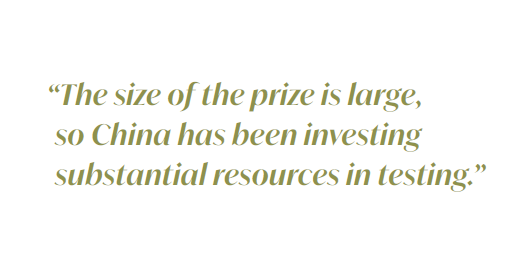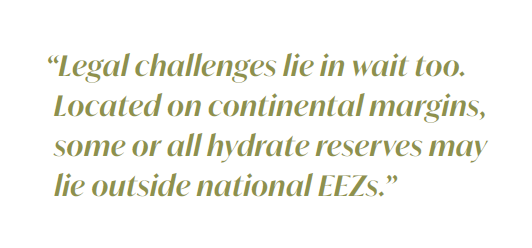Pursuing methane hydrates in the South China Sea [Gas in Transition]
China’s perennial worries about the sources and security of its gas imports have been a significant driver of its foreign policy for at least a decade, possibly two. But for much of that time it has been known that an enormous gas reserve lies on its littoral doorstep, if it could only be produced. That resource is frozen into a water/gas crystal lattice (or clathrate) on the continental slopes around the South China Sea.
To put that potential methane hydrate resource into perspective, exploration completed so far suggests (without complete certainty) that one deposit on China’s own continental slope extends for around 1,000 km along China’s coast, 100 km laterally and to some 200 m in depth. Those dimensions total 20,000 km3, or 20 trillion m3. That calculation leaves out deposits in more contested waters on the slopes of the Philippines, Vietnam and Taiwan.
Physics limit the reserve thickness to a few hundred metres
The size of the source sediment (not rock, this is loosely cemented sand or mud at geologically shallow depth) is constrained by the physics of clathrates.
The temperature and pressure conditions for hydrate formation start to occur at around 550 m of water depth, deeper in warmer seas, slightly shallower in colder ones. The bottom of the source formation is constrained by rising geothermal heat – below a certain depth from the sea bed the ambient temperature becomes too high for hydrate formation. So, methane hydrate can only exist within this narrow zone of pressure and temperature, referred to as the stability zone.
Research into the stability zone suggests that in most coastal margins it will be 300-600 n thick, but is thinner (100-200 n) off China’s coast.
Source sediment, but not necessarily gas-holding
Of course, the existence of the zone doesn’t prove the presence of hydrates. One paper by GEOMAR at Kiel compared the available global pore space in global stability zones with an estimate of total available methane (which comes from biogenic decay) over the past 10mn years and concluded that only 2.5% of a typical stability zone will contain methane hydrates.
But where the zone is gas-bearing it has been shown to be highly gas-rich. A single cubic metre of gassy sediment can carry about 150 m3 of gas. Factor those numbers together (2.5% and 150 m3) and we end up with a total resource on China’s littoral of a quite staggering 75 trillion m3 of gas. If the resource is only 100 m thick then halve that to 37.5 trillion m3. The lower number is just over 100 times China’s current annual total gas consumption, and some 250 times its current gas imports. The size of the prize is quite simply enormous, both financially and geopolitically.
Production challenges lie on every side
But access to the prize has proved problematic.
The easiest part is penetrating the source sediment with a well. Water depths are generally below 1,000 m – a fraction of the state of the subsea drilling art. Target sediments lie only a few hundred metres beneath the sea bed, and are 100-200 m thick. China has used horizontal wells, with nothing especially new to overcome. That makes the actual drilling a small task.
But the nature of the sediments create problems not experienced in conventional gas production. When gas is removed from the source sediment leaving liquid water in its wake (one gas molecule is held by eight water molecules) its physical properties change, and in particular its cementation and shear characteristics. In simple terms that means that production of large quantities of gas (with the destruction of large quantities of solid methane clathrate) is expected to cause the sediments to move, potentially catastrophically.
These seabed movements might cascade down the continental slope to create highly damaging tsunamis, and will certainly disrupt the well bore and its completion infrastructure. On top of that they are likely to disrupt the marine ecosystem living on top of the formation.
Cracking of the sediment can be problematic
As the sediment is drained it is also expected to open cracks above it. These will change the pressure/temperature environment in the reservoir and probably cause dissociated methane to cascade upwards into the overburden, where it will cause more physical disruption before entering the water column. In short, production of methane may cause the reservoir sediment to change to a substantial degree.
 Methane leakage into the water column may not be as disastrous as it sounds. Extensive experiments on seabed hydrate deposits have tended to show that gaseous methane is either dissolved back into seawater or consumed by bacterial action before it reaches the surface. The shallowest possible water depth for methane hydrate formation has been shown to be 480 metres. That said, a substantial methane leakage is likely to overwhelm both absorption routes and result in atmospheric methane release on a large scale.
Methane leakage into the water column may not be as disastrous as it sounds. Extensive experiments on seabed hydrate deposits have tended to show that gaseous methane is either dissolved back into seawater or consumed by bacterial action before it reaches the surface. The shallowest possible water depth for methane hydrate formation has been shown to be 480 metres. That said, a substantial methane leakage is likely to overwhelm both absorption routes and result in atmospheric methane release on a large scale.
A significant component of testing work has been the development of a comprehensive seabed methane monitoring infrastructure.
With these challenges in mind there is a great deal to be learnt from calculation and expensive experiments about how to keep the source sediment stable while extracting huge quantities of gas.
Production wells sand up
There are more problems along the way. In the South China Sea methane hydrates tested so far mostly sit in formations of clay, with very small pore sizes. The effect of that is to deepen the formation depth (a good thing) but to add sand to the flow of produced methane. Previous trials in Russia, Japan, the US and Canada found hydrates in coarse sandy sediments (Japan) and gravel sediments in the US and Canada. China’s sediments are generally in fine-grained sediments with a vein-like morphology which should keep sanding down.
Triggering dissociation is the next challenge
And then there is the challenge of how to dissociate the hydrate in the first place. The job is either to depressurise the sediment below the clathrate dissociation point (difficult inside a source sediment) or to increase the ambient temperature to above around 11 oC, or to change the physics of the clathrate structure by injecting some disruptive chemical. Past experiments appear to have taken the warming approach, but in scale that creates the question of where to get the input energy, at what cost, and with what second and third order effects on the reservoir down the time-line. China’s latest experiments have focused on depressurisation.
Injection of chemicals (and past experiments have tried gaseous Nitrogen and CO2) also complicates the chemical and PVT environment in the source sediment, as well as creating a new problem of purification back on the surface and corrosion in the production riser.
One Ukrainian study even proposed using waste heat from sea-bed mud volcanoes as the energy source. The sheer volume of gas per cubic metre will probably make the energy cost calculus a trivial obstacle but gas is fundamentally cheap, so it may not be as easy as producers would like.
Theory takes the producer only so far, with the true answers provided only by expensive tests.
Production needs to sit comfortably inside a cage of international law
Legal challenges lie in wait too. Located on continental margins, some or all hydrate reserves may lie outside national EEZs. If this is the case then their exploitation is limited to operations by states, or by companies supervised closely by states, and is governed by international law on pollution, greenhouse emissions and biological diversity. With the hydrate prize on its horizon it becomes clearer why China is so determined to impose its title to areas enclosed by the nine-dash line.
But the size of the prize is large, so China has been investing substantial resources in testing. Past tests include the chartering of the Bluewhale 1 semi submersible rig to explore in the Shenhu area of the South China Sea. In 2020 a 30-day test using depressurisation produced 28,000 m3/day for a month – more methane than all of the ten previous production tests across five countries combined. Gas was produced from a hydrate layer 200 m below the sea bed. The test might have taught China much about hydrate production, but at its lowest viable level a single rig’s production needs to be at least a hundred times larger before it even approaches commerciality.
More tests are on the way (or possibly already under way – China is tight with information on this highly strategic project). Bluewhale 1 was signed on to a 2.5 year charter for hydrate exploration in October last year. The natural resources ministry is talking about first commercial production in 2030.
Developing methane hydrates would also substantially disrupt the global gas export market in general, and the LNG market in particular. Whatever happens it seems likely that hydrate gas will cost more than conventional gas, but probably not enough to allow present profit margins on gas production to survive intact. And where China leads many other economies will probably follow. At root, hydrates pose a significant threat to conventional gas producers, and create a substantial opportunity for China in the export of effective production technology and techniques. It may be some way off, but if China succeeds we will see the first step in a geopolitical and energy market revolution.



